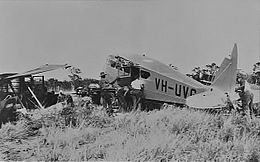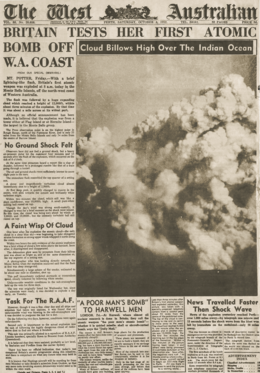William Hely
William Lloyd Hely | |
|---|---|
North-Western Area Command (1942–43) | |
| Commands held | North Australia Survey Flight (1936) No. 72 Wing (1944) No. 84 Wing (1944–45) Western Area Command (1951–53) Training Command (1956–57) Personnel Branch (1960–66) |
| Battles/wars | World War II |
| Awards | Commander of the Order of the British Empire Air Force Cross |
Hely spent the immediate post-war period on the staff of RAAF Headquarters,
Early career

The third child of Prosper Frederick Hely, a storekeeper, and his wife Alice (née Lloyd), William Lloyd (Bill) Hely was born on 24 August 1909 at
As well as the four graduates the Air Force had enrolled in 1927, budgetary constraints imposed during the Great Depression necessitated the transfer from Duntroon to Point Cook of eight other RAAF-sponsored cadets midway through their four-year course, including Alister Murdoch, Bill Garing and Douglas Candy.[3] Initially ranked pilot officer, Hely commenced his flying training course at RAAF Point Cook, Victoria, on 15 January 1931, graduating on 10 December.[4][6] His early postings as a pilot in 1932 and 1933 were to RAAF Station Richmond, New South Wales, and RAAF Station Laverton, Victoria. Qualifying in aerial photography, he served at Point Cook from 1933 to 1936.[1][2] He was then transferred to No. 3 Squadron at Richmond, receiving promotion to flight lieutenant.[1][7]

In April 1936, Hely took command of No. 3 Squadron's North Australia Survey Flight, one of two such
For its 1937 aerial survey program, the RAAF formed the Communications and Survey Flight under
World War II

At the outbreak of World War II, Hely was attached to the operations room at
In May 1944, Hely assumed command of
Post-war career

Hely relinquished command of No. 84 Wing on 12 August 1945 and returned to RAAF Headquarters in October.[1][28] He was by this time among a coterie of officers at group captain level, including Val Hancock, Alister Murdoch and Bill Garing, earmarked by the Australian Air Board for leadership roles in the post-war RAAF, which was to shrink rapidly with demobilisation.[29][30] At RAAF Headquarters, Hely was appointed deputy director of Operations, in which capacity he served on a committee to investigate proposals for an officer training college, later established as RAAF College, Point Cook. Along with Hely, all officers associated with the proposal's examination were former Duntroon students, including the Deputy Chief of the Air Staff, Air Commodore Frank Bladin, the Director of Postings, Group Captain Murdoch, and the Director of Training, Group Captain Paddy Heffernan. Another Duntroon graduate, Air Commodore Hancock, became the college's first commandant.[31] Hely was appointed Director of Organisation and Staff Duties in 1946. That November, he became Director of Postings.[2][32] The following year, he took up the position of Director of Personal Services, before departing for Britain in December 1948 to study at the Imperial Defence College, London.[1][2]
Returning to Melbourne, Hely served as deputy to the Air Member for Personnel from January 1950.
Between October 1953 and February 1954, the RAAF underwent major organisational change, as it transitioned from a

Hely became Air Member for Personnel (AMP) on 28 March 1960, taking over from the acting AMP, Air Commodore
Retirement
Hely retired on 24 August 1966, after almost forty years in the military.[5][57] He was succeeded the following day as AMP by Air Vice Marshal Candy.[44] In retirement, Hely was active in the Canberra branch of the Air Force Association. He died of cancer in Canberra on 20 May 1970. Survived by his wife and children, he was accorded an Air Force funeral at St John the Baptist Church and cremated at Norwood Park Crematorium, Gungahlin.[1][58] The official mourning party included Chairman of the Chiefs of Staff Committee (CCOSC) General Sir John Wilton, former CCOSC Air Chief Marshal Sir Frederick Scherger, Secretary of Defence Sir Arthur Tange, CAS Air Marshal Colin Hannah, former CAS Air Marshal Sir Alister Murdoch, Vice Admiral Sir Victor Smith, Air Vice Marshal Brian Eaton, and Group Captain John Waddy. The guns at Duntroon were fired in salute as the cortege left the church.[58]
Notes
- ^ a b c d e f g h i j k l m n o p q r Eaton, Brian. "Hely, William Lloyd (Bill) (1909–1970)". Australian Dictionary of Biography. National Centre of Biography, Australian National University. Retrieved 28 May 2013.
- ^ a b c d e f g h i j k "Air Vice-Marshals (A–K)". Air Marshals of the RAAF. Air Power Development Centre. Archived from the original on 6 July 2012. Retrieved 28 May 2013.
- ^ a b Coulthard-Clark, The Third Brother, pp. 193, 196–197
- ^ a b Frost, RAAF College & Academy, xv
- ^ a b "Hely, William Lloyd". World War 2 Nominal Roll. Retrieved 28 May 2013.
- ^ Coulthard-Clark, The Third Brother, p. 198
- ^ The Argus. Melbourne: National Library of Australia. 16 April 1936. p. 11. Retrieved 28 May 2013.
- ^ a b Coulthard-Clark, The Third Brother, pp. 431–432
- ^ "Flight-Lieut. Hely's graphic account". The Sydney Morning Herald. Sydney: National Library of Australia. 25 April 1936. p. 15. Retrieved 28 May 2013.
- ^ "25 Planes seek in vain for missing Stinson". The Courier-Mail. Brisbane: National Library of Australia. 22 February 1937. p. 13. Retrieved 28 May 2013.
- ^ "Missing airliner found". Kalgoorlie Miner. Kalgoorlie, Western Australia: National Library of Australia. 1 March 1937. p. 4. Retrieved 28 May 2013.
- ^ Coulthard-Clark, The Third Brother, pp. 433–435
- ^ Coulthard-Clark, The Third Brother, pp. 436–437
- ^ "Plane Crash". The Canberra Times. Canberra: National Library of Australia. 22 November 1937. p. 2. Retrieved 28 May 2013.
- ^ "Seven knighthoods in eastern states". The Recorder. Port Pirie, South Australia: National Library of Australia. 9 June 1938. p. 1. Retrieved 28 May 2013.
- ^ "No. 34518". The London Gazette (Supplement). 9 June 1938. p. 3709.
- ^ Gillison, Royal Australian Air Force, pp. 143–144 Archived 1 July 2015 at the Wayback Machine
- ^ Bussemaker, Herman (November 1996). "Australian-Dutch defence cooperation, 1940–1941". Journal of the Australian War Memorial, Issue 29. Retrieved 2 June 2013.
- ^ "Airman promoted". The Examiner. Launceston, Tasmania: National Library of Australia. 17 February 1942. p. 4. Retrieved 28 May 2013.
- ^ Helson, The Forgotten Air Force, pp. 70–71, 80–81
- ^ "Many RAAF officers promoted". The Argus. Melbourne: National Library of Australia. 29 January 1943. p. 3. Retrieved 28 May 2013.
- ^ Funnell, Ray. "Walters, Allan Leslie (1905–1968)". Australian Dictionary of Biography. National Centre of Biography, Australian National University. Retrieved 28 May 2013.
- ^ Odgers, Air War Against Japan, pp. 114–116 Archived 27 April 2015 at the Wayback Machine
- ^ a b c Odgers, Air War Against Japan, pp. 318–327
- ^ Odgers, Air War Against Japan, p. 440 Archived 18 April 2015 at the Wayback Machine
- ^ Odgers, Air War Against Japan, p. 317 Archived 14 July 2015 at the Wayback Machine
- ^ a b Parnell; Lynch, Australian Air Force Since 1911, p. 97
- ^ No. 84 (Army Cooperation) Wing. "Operations record book". p. 31. Retrieved 28 May 2013.
{{cite web}}: CS1 maint: numeric names: authors list (link) - ^ Helson, Ten Years at the Top, pp. 237–238
- ^ Stephens, Going Solo, pp. 24–27
- ^ Frost, RAAF College & Academy, pp. 1–2, 9
- ^ "Appointments to high RAAF posts". The Argus. Melbourne: National Library of Australia. 9 November 1946. p. 3. Retrieved 28 May 2013.
- ^ "Australians as aides to the King". The Sydney Morning Herald. Sydney: National Library of Australia. 8 June 1951. p. 4. Retrieved 28 May 2013.
- ^ "New officer appointed to lead RAAF in WA". The West Australian. Perth: National Library of Australia. 8 September 1951. p. 2. Retrieved 28 May 2013.
- ^ "New air chief on citizen training". The West Australian. Perth: National Library of Australia. 24 September 1951. p. 2. Retrieved 28 May 2013.
- ^ "Promotion in RAAF". The West Australian. Perth: National Library of Australia. 2 July 1952. p. 7. Retrieved 28 May 2013.
- ^ "Six RAAF officers promoted". The West Australian. Perth: National Library of Australia. 5 September 1952. p. 4. Retrieved 28 May 2013.
- ^ "Aides-de-camp to the Queen". The Sydney Morning Herald. Sydney: National Library of Australia. 12 September 1952. p. 5. Retrieved 28 May 2013.
- ^ "Atomic Weapon Tested". Benalla Ensign. Victoria: National Library of Australia. 27 November 1952. p. 11. Retrieved 2 April 2013.
- ^ "No. 39865". The London Gazette (Supplement). 1 June 1953. p. 2998.
- ^ a b "RAAF Air Board member retires". RAAF News. Vol. 8, no. 8. September 1966. p. 3.
- ^ "Hely will be Deputy Chief of Air Staff". The West Australian. Perth: National Library of Australia. 25 August 1953. p. 3. Retrieved 28 May 2013.
- ^ Stephens, Going Solo, pp. 74–77
- ^ a b c Stephens, Going Solo, pp. 499–500
- ^ "RAAF's new training chief". The Argus. Melbourne: National Library of Australia. 25 January 1956. p. 8. Retrieved 28 May 2013.
- ^ "New deputy air chief". The Argus. Melbourne: National Library of Australia. 4 April 1956. p. 3. Retrieved 10 March 2014.
- ^ "Goodbye to the Tiger Moth". Air Power Development Centre. 9 January 1957. Retrieved 28 May 2013.
- ^ "Air Vice-Marshals (L–Z)". Air Marshals of the RAAF. Air Power Development Centre. Archived from the original on 1 June 2011. Retrieved 28 May 2013.
- ^ a b c Stephens, Going Solo, pp. 88–89
- ^ Stephens, The Royal Australian Air Force, p. 52
- ^ Stephens, Going Solo, p. 501
- ^ "No. 43201". The London Gazette (Supplement). 1 January 1964. p. 35.
- ^ "Nineteen in honours list". RAAF News. Vol. 6, no. 1. January–February 1964. p. 7.
- ^ Coulthard-Clark, From the Ground Up, pp. 109–113
- ^ Frost, RAAF College & Academy, pp. 49–52
- ^ Stephens, The Royal Australian Air Force, pp. 188–189
- ^ "Senior RAAF officer retires". The Canberra Times. Canberra: National Library of Australia. 25 August 1966. p. 24. Retrieved 28 May 2013.
- ^ a b "Tributes to AVM Hely". RAAF News. Vol. 12, no. 6. July 1970. p. 3.
References
- Coulthard-Clark, Chris (1991). The Third Brother: The Royal Australian Air Force 1921–39. North Sydney: ISBN 0-04-442307-1. Archived from the originalon 16 December 2013.
- Coulthard-Clark, Chris (1997). From the Ground Up: The Training of RAAF Technical Ground Staff, 1948–1993 (PDF). Canberra: Air Power Studies Centre. ISBN 0-642-26509-7.
- Frost, R.E. (1991). RAAF College & Academy 1947–86 (PDF). Canberra: ISBN 978-0-646-08518-0.
- Gillison, Douglas (1962). Australia in the War of 1939–1945: Series Three (Air) Volume I – Royal Australian Air Force 1939–1942. Canberra: OCLC 2000369.
- Helson, Peter (1997). The Forgotten Air Force: The Establishment and Employment of Australian Air Power in the North-Western Area, 1941–1945 (Masters thesis). Canberra: OCLC 224054611.
- Helson, Peter (2006). Ten Years at the Top (PhD thesis). Sydney: OCLC 225531223.
- OCLC 246580191.
- Parnell, N.M.; Lynch, C.A. (1976). Australian Air Force Since 1911. Sydney: A.H. & A.W. Reed. ISBN 0-589-07153-X.
- Stephens, Alan (1995). Going Solo: The Royal Australian Air Force 1946–1971. Canberra: ISBN 0-644-42803-1.
- Stephens, Alan (2006) [2001]. The Royal Australian Air Force: A History. London: ISBN 978-0-19-555541-7.
